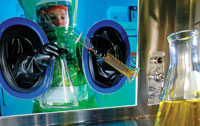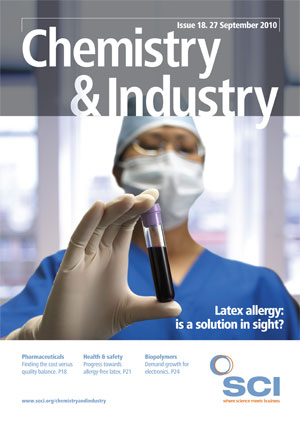Growing concerns over counterfeit and adulterated foods and medicines, highlighted for example by recent contamination episodes involving the widely used drug products heparin and glycerin, have increased attention on risk management and supply chain integrity in the pharma and food industries in recent years. While quality assurance and product safety have always been paramount in these industries, growing pressure from consumers at the other end of the supply chain means that their suppliers are now tasked with meeting even more stringent quality and supply chain integrity requirements.
Back in the 1990s, quality control was taken as a given, and a Certificate of Analysis (C of A) from its suppliers was often sufficient to meet a pharmaceutical company’s quality assurance needs. Since 2000, however, the emphasis has shifted from quality control to product origin, on-time delivery, risk mitigation and, more recently, supply chain transparency. Customers have a renewed focus on quality, trust, reliability and sustainability and now everyone from start-ups to universities has to be more compliant with quality standards upfront, often needing to provide proof of product integrity to secure funding. Having proper controls during the research phase allows for a more fluid transfer from research into development and finally into manufacturing.
True cost of quality
As Asia Pacific manufacturing has matured, so the focus on maximising profitability by globally sourcing raw materials and manufacturing has moved eastwards. However, lower costs have sometimes unfortunately been accompanied by more relaxed interpretations of quality, health, safety and environmental matters, which have in turn occasionally caused severe problems for consumers and patients. The tragic human costs, the tarnished reputations of the companies involved – and of the industry as a whole – combined with the fi nancial and legal implications, mean that risk mitigation is a key condition of any outsourcing to a contract manufacturer.
The World Health Organization (WHO) estimates that 10% of all global medicines and up to 30% of medicines sold in developing countries may be counterfeit, with some studies suggesting that this figure may be even higher. The pharmaceutical industry has learned the hard way that producing products with price as the sole driver can lead to severe quality problems. Put simply, the cost of quality is no longer dollars per gram.
As a result, the industry is looking to see continual improvements in the quality systems governing the critical raw materials that it uses, combined with increased supply chain integrity. Also, it is a clear priority of regulatory bodies such as the US Food and Drug Administration (FDA) to focus on these areas of concern and to ensure that these are addressed throughout the supply chain.
Quality ‘sweet spot’
With varying quality requirements for raw materials ranging from ISO 9001 to good manufacturing practice (cGMP), manufacturers require the flexibility to obtain products with the right quality level at the appropriate cost – finding a sweet spot that does not compromise quality but still allows cost effective production. Being able to meet these criteria is an issue facing many suppliers to the pharma and biopharma industries. At fine chemicals company SAFC, for example, we have a portfolio of over 100,000 products; it would not be possible to offer every product under cGMP, nor would there be a market for all of them even if it were.
SAFC’s Enhanced Quality Profile (EQP) programme is designed to take account of the breadth of chemistries represented within this portfolio; the fact that the majority of products are designed for research applications; and the practical limitations of manufacturing all products under cGMP. It characterises an individual product’s quality traits across a four-level quality system: standard, premium, elite and cGMP. The programme is designed to assist customers in better managing product change risk while providing peace of mind that a product’s quality profile meets their individual manufacturing requirements. The system provides customers with batch-specific information and covers issues like standardised policies and procedures, documented product specifications and analytical methods, certificates of origin, quality assurance review and release, change control notification – which is based on a combination of the type of change and the level of product quality to offer product transparency, lot sample retention, vendor management and performance evaluation.
The upper classifications of the EQP system recognise ISO 9001:2008 requirements plus elements of other international standards, such as the International Conference on Harmonization (ICH) and European Directorate for the Quality of Medicines and Health Care (EDQM). The programme links customers with a Change Control Notification (CCN) process and customers who have submitted a formal request for inclusion in the CCN programme are notified for specific areas of change or potential change.
Greater transparency?
The US Government Accountability Office states that only 11% of manufacturing sites outside of the US were inspected by the FDA in 2007, including only 19 of 700 sites in China. This situation is likely to change, but only in the longer term, with President Barack Obama recently pointing out that underfunding and under-staffing at FDA has left the agency unable to conduct annual inspections of more than a fraction of the 150,000 food processing plants and warehouses in the US, which ‘is a hazard to public health. It is unacceptable,’ Obama commented.

Rx-360 is made up of regulators, pharmaceutical executives, supplier executives and members of professional organisations whose common aim is to serve patients. Its mission is to create and monitor a global quality system that meets the expectations of industry and regulators that assures patient safety by guaranteeing product quality and authenticity throughout the supply chain.
While legislators, regulators and other organisations around the world are developing and implementing local measures to secure integrity of supply, Rx-360 aims to complement these efforts and deliver a level of consistency and scope worldwide that local measures cannot achieve. The consortium has four distinct functions that will be performed collectively:
- Adopting standards and best practices: the consortium will scan external sources for the best available standards today that will assist in improving the performance of the supply chain. The goal will be to prompt consortium members to adopt best practices with a sense of urgency. After implementation, the consortium will look to identify future improvements from any existing gaps in the standards.
- Technology development: the consortium will work with research organisations, such as the Massachusetts Institute of Technology (MIT) and University of California at Berkeley, and research institutions in Europe, to develop new technologies that will secure the supply chain and to detect if there has been tampering with the supply chain.
- Monitoring: the consortium will act as a clearing house for suspicious supplier and supply chain information that might impact patient safety, such as suspected tampering, contamination, adulteration of materials or disruption signs in the supply chain causing a shortage, potentially leading unethical individuals to counterfeit or adulterate materials for economic gain at the expense of patient safety. Members will report suspicious events to the consortium, which will disseminate the initial information, evaluate the impact of this on its members and then develop potential proactive solutions for them to consider adopting.
- Shared supplier audits: the consortium will provide a wide range of auditing services such as cGMP, Good Documentation Practices (GDP), environment, health and safety (EHS) and supply chain security. The consortium will develop a system that will make audits broader and more thorough, and allow firms to share audit findings and corrective actions making the system more effective and efficient. The concept will reduce the number of audits at a particular supplier but increase the effectiveness of the audits performed. Each manufacturer will then take this information and make their own independent assessments on the appropriateness of a supplier based on their own company policies and product needs.
Rx-360 chairman and Amgen’s vice president of quality, Martin Van Trieste states: ’Patient safety should never be a competitive advantage. By building this consortium and bringing together leaders from the pharmaceutical and biotechnology industries, our suppliers and regulatory agencies, we can begin to address more directly and swiftly issues critical to a safe and successful supply chain.’
Although not every product supplied to the pharmaceutical industry is currently regulated or licensed by a governmental agency, the sector rightly expects an equivalent level of controls, systems and compliance. Given numerous instances where a lack of transparency, quality assurance and regulatory compliance has led to dangerous, even deadly, consequences, it is unsurprising that both accountability and visibility are increasingly significant in pharmaceutical development and manufacturing. Initiatives such as Rx-360 indicate that the industry is facing up to and addressing these issues.
Tom Beil is vice-president of quality and regulatory affairs at SAFC, based in St Louis, Missouri, US.




